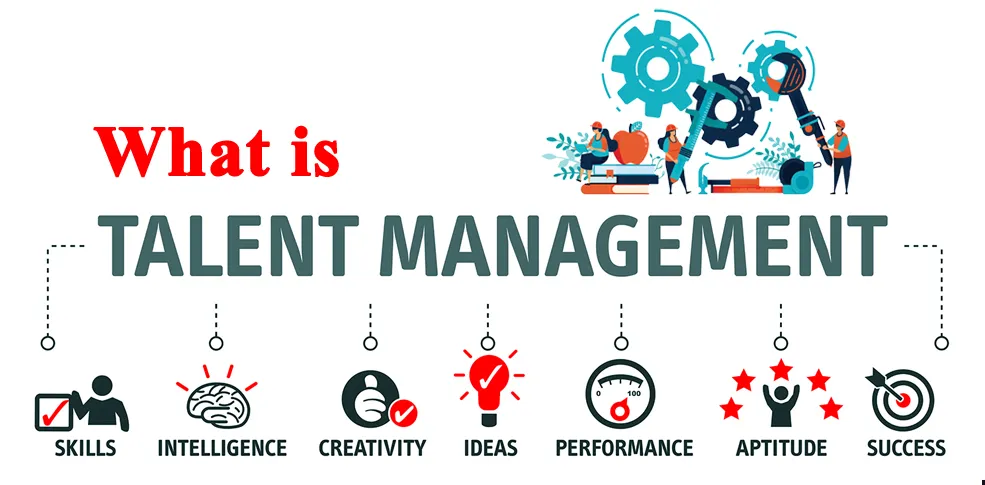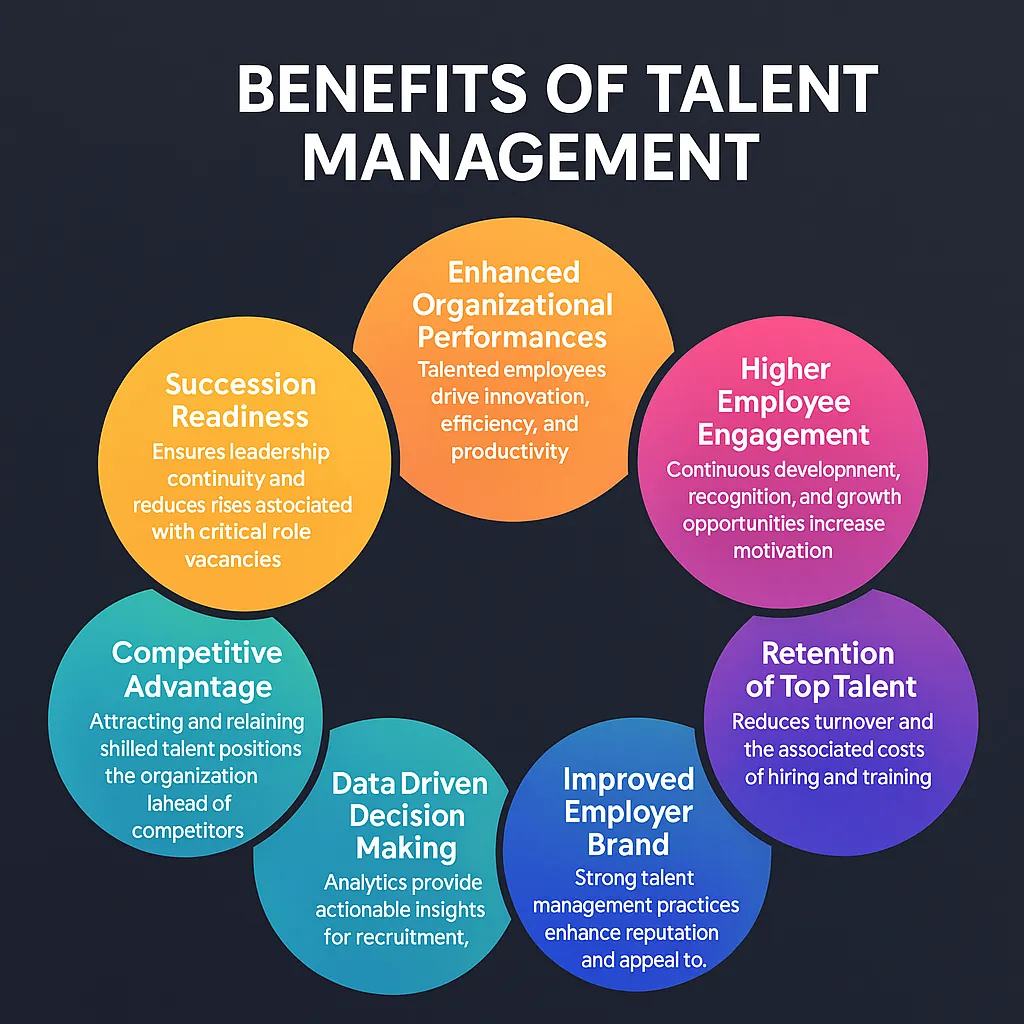
Executive Summary
Talent management is a strategic approach that organizations use to attract, develop, retain, and deploy skilled employees to achieve business objectives. It encompasses the entire employee lifecycle, from recruitment and onboarding to performance management, learning and development, succession planning, and employee engagement.
In today’s competitive business environment, talent is one of the most critical assets for an organization. Effective talent management ensures that the right people are in the right roles, performing at their best, and contributing to organizational success. This guide explores the concept of talent management, its components, processes, benefits, challenges, strategies, and future trends.
Table of Content
Introduction
Talent management has become a cornerstone of organizational strategy in the modern workplace. With rapid technological changes, globalization, and evolving workforce expectations, businesses must ensure they have the talent needed to meet strategic objectives.
Beyond simply hiring employees, talent management focuses on maximizing the value of each employee through strategic planning, development opportunities, recognition, and retention initiatives. It integrates human resources, leadership development, performance management, and workforce planning to create a cohesive system that supports both employees and organizational goals.
Core Concepts of Talent Management
- Attraction and Recruitment – Identifying and acquiring skilled individuals who align with organizational values and culture.
- Onboarding – Integrating new employees effectively into the organization, helping them understand roles, responsibilities, and organizational culture.
- Performance Management – Monitoring, evaluating, and improving employee performance through feedback and structured evaluations.
- Learning and Development – Providing training, mentorship, and development programs to enhance employee skills and competencies.
- Succession Planning – Preparing high-potential employees for key roles to ensure continuity and future leadership.
- Employee Engagement and Retention – Fostering motivation, satisfaction, and loyalty to reduce turnover.
- Workforce Planning – Aligning talent resources with organizational needs and strategic goals.
- Recognition and Rewards – Incentivizing employees to reinforce high performance and loyalty.
Key Processes in Talent Management
1. Talent Acquisition and Recruitment
- Conducting workforce planning to identify current and future talent needs.
- Sourcing candidates through job boards, social media, employee referrals, and recruitment agencies.
- Implementing structured interviews, assessment tests, and background checks.
- Ensuring diversity, equity, and inclusion in hiring processes.
2. Onboarding and Integration
- Introducing new hires to company culture, policies, and team structures.
- Providing role-specific training to ensure a smooth transition.
- Assigning mentors or buddies to support early engagement.
3. Performance Management
- Setting clear goals aligned with organizational objectives.
- Using KPIs, OKRs, or performance scorecards to monitor progress.
- Providing continuous feedback and coaching for improvement.
- Conducting annual or bi-annual appraisals to evaluate performance.
4. Learning and Development
- Identifying skill gaps and offering targeted training programs.
- Providing leadership development and succession planning opportunities.
- Encouraging continuous learning through workshops, e-learning, and certifications.
- Promoting cross-functional training to broaden employee expertise.
5. Succession Planning and Career Pathing
- Identifying high-potential employees for critical roles.
- Developing individualized career development plans.
- Preparing talent pipelines for future leadership or strategic roles.
- Ensuring knowledge transfer to prevent skill gaps when employees leave or retire.
6. Employee Engagement and Retention
- Conducting surveys to measure satisfaction and engagement.
- Implementing flexible work arrangements and wellness programs.
- Recognizing and rewarding performance through bonuses, promotions, or awards.
- Encouraging a positive organizational culture that fosters loyalty.
7. Workforce Analytics and Planning
- Collecting and analyzing data on recruitment, performance, turnover, and skills.
- Using predictive analytics to forecast talent needs and identify retention risks.
- Aligning workforce plans with business strategy to optimize talent deployment.
Benefits of Talent Management

- Enhanced Organizational Performance – Talented employees drive innovation, efficiency, and productivity.
- Higher Employee Engagement – Continuous development, recognition, and growth opportunities increase motivation.
- Retention of Top Talent – Reduces turnover and the associated costs of hiring and training.
- Succession Readiness – Ensures leadership continuity and reduces risks associated with critical role vacancies.
- Competitive Advantage – Attracting and retaining skilled talent positions the organization ahead of competitors.
- Improved Employer Brand – Strong talent management practices enhance reputation and appeal to potential employees.
- Data-Driven Decision Making – Analytics provide actionable insights for recruitment, retention, and development strategies.
Talent Management Strategies
- Employer Branding – Creating a compelling value proposition to attract top candidates.
- Employee Value Proposition (EVP) – Highlighting what makes the organization a desirable place to work.
- Structured Career Development Programs – Offering clear career paths and growth opportunities.
- Performance-Based Incentives – Linking rewards to achievement and contribution.
- Flexible Work Policies – Supporting work-life balance to increase engagement and retention.
- Diversity, Equity, and Inclusion Initiatives – Building a culture that values varied perspectives.
- Continuous Learning Culture – Encouraging employees to acquire new skills and competencies regularly.
- Succession Planning and Mentorship Programs – Preparing the next generation of leaders.
- Use of Technology and Analytics – Implementing HR software for performance tracking, recruitment, and talent planning.
- Feedback and Recognition Programs – Reinforcing positive behaviors and creating a culture of continuous improvement.
Tools and Technologies in Talent Management
- HR Management Systems (HRMS): Workday, SAP SuccessFactors, Oracle HCM, BambooHR
- Recruitment Platforms: LinkedIn Talent Solutions, Indeed, Lever, Greenhouse
- Learning Management Systems (LMS): Cornerstone OnDemand, Udemy for Business, Coursera for Teams
- Performance Management Software: Lattice, 15Five, Reflektive
- Engagement and Feedback Tools: Culture Amp, Glint, TINYpulse
- Workforce Analytics Tools: Visier, Tableau, Power BI for talent insights
- Collaboration Tools: Slack, Microsoft Teams for communication and engagement initiatives
Challenges in Talent Management

- Talent Shortages – Difficulty finding candidates with specialized skills.
- Retention Issues – High turnover of top-performing employees.
- Alignment with Business Strategy – Ensuring talent initiatives support organizational objectives.
- Adapting to Remote and Hybrid Work – Managing performance and engagement in distributed teams.
- Bias and Inequality – Avoiding discrimination and ensuring fair opportunities.
- Rapid Technological Changes – Keeping skills relevant amidst evolving tools and platforms.
- Measuring ROI – Quantifying the impact of talent management initiatives on business outcomes.
- Employee Engagement – Maintaining high engagement, motivation, and morale over time.
Real-World Applications
- Corporate Organizations – Developing pipelines for leadership roles and skill-specific positions.
- Healthcare Industry – Ensuring skilled practitioners and nursing staff are recruited, trained, and retained.
- IT and Technology Firms – Keeping talent updated on rapidly evolving technical skills and certifications.
- Manufacturing – Training workers for safety, efficiency, and process optimization.
- Education and Academia – Developing faculty talent through professional development and leadership programs.
- Hospitality and Service Industries – Retaining skilled personnel to ensure quality customer service and operational efficiency.
- Government and Public Sector – Managing skilled workforce for effective public administration and service delivery.
Key Metrics and KPIs
- Time to Hire – Duration between job posting and candidate acceptance.
- Employee Turnover Rate – Percentage of employees leaving the organization over a period.
- Employee Engagement Score – Measurement of motivation, satisfaction, and commitment.
- Training Completion Rate – Percentage of employees completing development programs.
- Succession Readiness – Number of key roles with identified successors.
- Performance Ratings Distribution – Spread of performance levels across the organization.
- Retention of High-Potential Employees – Ability to retain top talent for critical roles.
- Internal Mobility Rate – Number of employees promoted or moved to new roles internally.
- Recruitment Cost per Hire – Total cost of hiring divided by number of hires.
- Diversity Metrics – Representation of various groups in hiring, promotions, and leadership positions.
Common Misconceptions
- Talent Management is Only HR’s Responsibility – It requires leadership involvement, cross-functional collaboration, and organizational alignment.
- It’s Only About Recruitment – It covers the entire employee lifecycle, including development, retention, and engagement.
- High Compensation Alone Retains Talent – Engagement, career growth, culture, and recognition are equally important.
- Technology Replaces Human Interaction – Tools support, but strategic decision-making, mentorship, and personal relationships remain critical.
- It Guarantees Instant Results – Talent management is a long-term investment requiring consistent effort.
Future of Talent Management
- AI and Predictive Analytics – Forecasting talent needs, identifying retention risks, and personalizing development.
- Remote Work and Hybrid Teams – Developing new strategies for engagement, collaboration, and performance tracking.
- Continuous Learning and Upskilling – Emphasizing lifelong learning to maintain a competitive workforce.
- Employee Experience Focus – Designing holistic experiences to improve satisfaction and productivity.
- Diversity, Equity, and Inclusion – Strengthening inclusive practices to attract and retain diverse talent.
- Integrated HR Technology Platforms – Centralized systems combining recruitment, learning, performance, and engagement.
- Data-Driven Talent Decisions – Using analytics to guide recruitment, retention, and succession planning.
- Personalized Career Pathing – Offering tailored development and advancement opportunities.
Conclusion
Talent management is a strategic, integrated approach that ensures organizations attract, develop, retain, and engage the right people in the right roles. By aligning talent strategies with business objectives, organizations can drive performance, foster innovation, and maintain a competitive edge. Effective talent management involves continuous investment in employees, leveraging technology, and creating a culture of engagement, growth, and recognition.
In an era where human capital is one of the most valuable assets, organizations that excel in talent management are better positioned to achieve long-term success, retain top performers, and cultivate future leaders.


